When Poland regained independence, completely new elites emerged on the candlestick, which very quickly took a taste for high life. Those who not so long ago wandered around the musty halls printing illegal newspapers, now attended presidential receptions. And they made a show of themselves often.
Zofia Kirkor-Kiedroniowa had a lot of fun. As the wife of a minister of industry and commerce (and one in the government formed by her own brother), even if she really wanted to, she would simply not be able to get out. Going to balls, balikas, banquets, clubs and other social events for the society belonged in a way to the duties of the minister.
She was, inter alia, at the rutta in the French legation in June 1924, organized on the occasion of the visit of five bishops from the Seine. For this occasion, she set up an exceptionally elegant toilet, which her husband gave her (showing unprecedented generosity) on one of the family occasions. It only took a few minor adjustments and ... she wore the same elegant dress to all social gatherings throughout the season.
Elites matching Polish possibilities
The minister was not ashamed of putting on one garment over and over again, or the fact that she and her husband were driving a rickety car. Such were the realities. As she herself mentioned:
Many times, I also had to eat. The minister of industry and trade did not have any funds for representation, ministerial salaries were small, my income (percentages on the mortgage) decreased [...] so only once, at the end of the season, we repaid all those who welcomed us with dinners or lunches - parade déjeuner published by us in the Merchant Resursa.
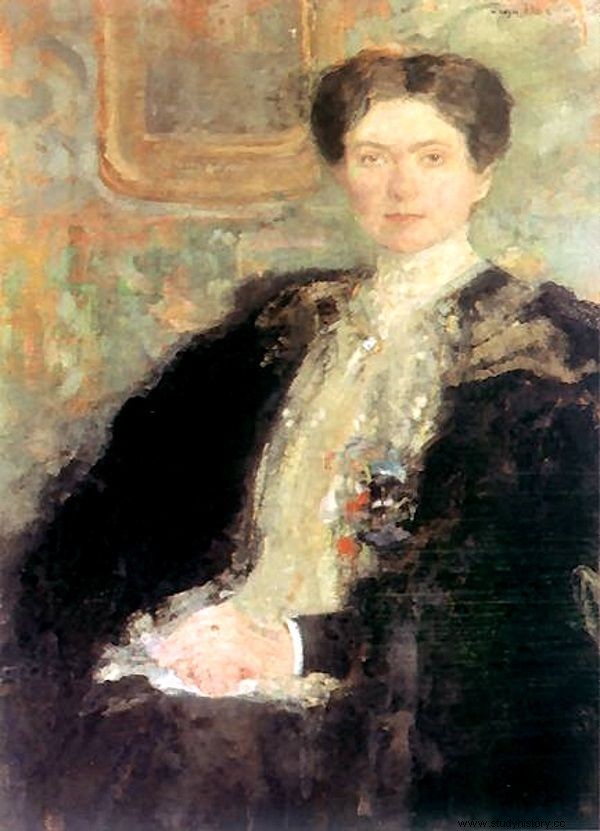
Zofia Kirkor-Kiedroniowa in the portrait by Olga Bozańska (photo:public domain).
If you were a member of an elegant society, it was also considered good to receive visits to your home on certain days of the week and month. The hostess herself set these fixed dates and thus undertook that she would be present and at the disposal of her guests.
A fixed day of admissions. The iron duty of a good housewife
Unless there has been some terrible complication, such as a broken leg or a funeral, dodging jour fixe , that is, of the regular reception day, was the social blunder of the first water. On this occasion, it was not necessary to prepare a great feast, because it was not about feasting. The guest was offered a cup of tea and small, shortbread cookies. It seems like an elegant set, but there is a bottom line behind its simplicity.
As Kirkor-Kiedroniowa emphasized, on the day of the parties, about 150 people would come through her salons (the right one, and also ... the son's room, which was converted for the visit), from five to eight in the evening, usually about 150 people.
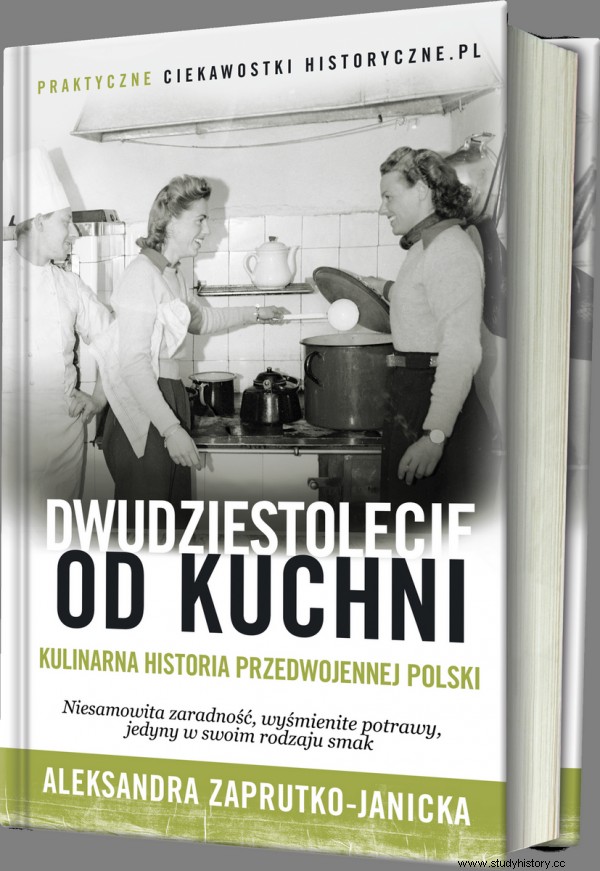
Incredible resourcefulness, delicious dishes, unique taste. Learn about the female history of pre-war Poland in the book "Twenty years from the kitchen" by Ola Zaprutko-Janicka.
Among them, the highest officials in the state, representatives of the diplomatic corps, but also various officials, close and distant friends, relatives, friends, journalists, writers and many others. If she wanted to feed this whole bunch with something a little more complicated than biscuits, she would need a substantial sum of money that, as a minister, she simply did not have.
First Lady's savings
Kirkor-Kiedroniowa complained about the lack of funds to conduct a social life corresponding to her husband's function. What was yet to be said by Maria Wojciechowska , the president's wife?
The Warsaw elite, in search of splendor and splendor, looked towards a person who seemed naturally predestined to them. Meanwhile, the spouse of the head of state felt absolutely uncomfortable in her role. Whenever there was an opportunity, she fled to a residence in Spała, and limited her contact with society to a minimum. Kamil Janicki writes about it extensively in the book "First Ladies of the Second Republic".
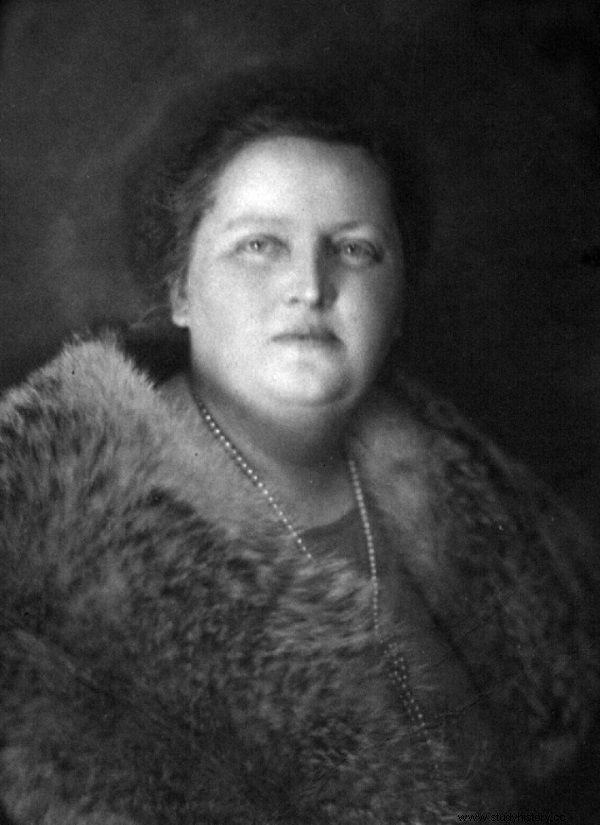
Maria Wojciechowska, wife of the President of the Republic of Poland Stanisław Wojciechowski (photo:public domain).
In Belweder, whether Wojciechowska wanted it or not, there were parties all the time. However, the Presidential did not give up easily and you could see her hand in their shape. The adjutant of the head of state, Henryk Comte, emphasized in his memoirs that Maria was far from extravagant, although "there would be something". His comment, however, was a huge understatement. Wojciechowska turned out to be morbidly frugal.
In the capital, the society ladies laughed a bit at her, because she wanted to keep control of her family's budget, as the wife of the minister of the interior (her husband's previous position), she did her own shopping. So ordinary Warsaw residents could meet the very honorable wife of one of the first people in the country ... in the queue for parsley.
Maria was not used to the fact that she had to aspire to certain standards so as not to diminish the importance of the office of her spouse Stanisław. Against this background, sometimes bizarre situations occurred. The president, while staying in Spała, invited her guests for breakfast and seated them at a table covered with not beautiful napkins or elegant tablecloths, but with an ordinary white sheet, with a large hole in the middle. Therefore, it is not surprising that the teas, banquets and other parties she organized were also not sumptuous.
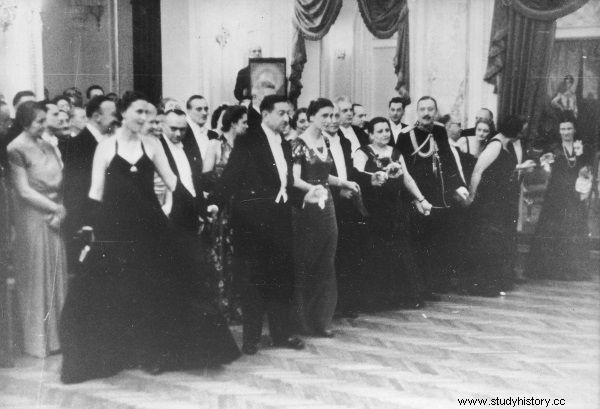
Maria Wojciechowska stood out from the elite who wanted to play at balls such as the one in the photo, in the officers' casino (photo:public domain).
First Lady's inedible donuts
Some people, however, appreciated this lack of pomposity and modesty, especially when it comes to "Thursday dinners". Following the example of Stanisław August Poniatowski, the presidency began on Thursdays to organize meetings of people of culture and art, along with a small snack. Taking into account the fact that the host was the head of state, the tables could feature mountains of goodies from the popular Blikle or straight from the shop windows of Mała Ziemiańska, occupied by an artistic bohemian. But that would not be allowed by the passion for saving the first lady.
Instead of sweets from professional confectioners, the guests had the opportunity to try Wojciechowska's donuts according to a family recipe and ordinary tea. Mrs. Maria assumed that if these fatty balls fried in deep fat taste good for her, her husband and children, they must appeal to her guests as well. Unfortunately, even with the best intentions and the highest respect for the Wojciechowski family, it was difficult to swallow them.
As Kamil Janicki pointed out in his biography of the pre-war first ladies, even Jan Skotnicki, the director of the culture department, who had a lot of affection for them, recalled that the donuts in question were heavy, unsuccessful and lanky.
After the May coup in 1926, Ignacy Mościcki took the office of president and he barely made himself at home, and there was a 180-degree change. In the earlier years of his life, the future head of state was far from being glitz and elite. Mościcki, chasing the national idea, has been living in real poverty for many years. Also, his wife Michalina did not come from a wealthy home (her father was a completely bankrupt landowner, and her mother ... Mościcki's aunt). They lived in exile for a long time, where the future president pursued a scientific career, continued after Poland regained independence on the Vistula River.
However, when he was elected to the highest office, he unexpectedly discovered that he was in his element. The actual power in the country was held by Marshal Piłsudski, so Mościcki had plenty of time to "perform representative functions". And he wasn't going to waste it. The halls of elegant men dressed in tailcoats and gala uniforms marched along the corridors of the Royal Castle. The problem, however, was that although Mościcki dreamed of high life, people from the Polish elite who, for one reason or another, were in his company, simply did not follow this vision. As commented by Henryk Comte, a former aide and now a member of the honorary campaign:
Many Polish guests, without any salon experience, were anxiously looking at the great variety of porcelain, crystal, gilded and silverware, not knowing what it was used for and how to use it. He discreetly watched how the neighbor behaved. It happened that this one was also helpless. Back then, both of them had at least the consolation that they did not feel alone.
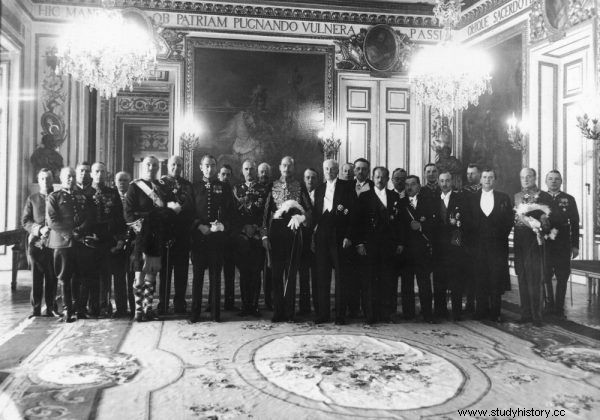
Ignacy Mościcki in his element - dressed in a tuxedo, surrounded by diplomats at the Royal Castle (photo:public domain).
Comte did not feel sorry for the lack of sophistication of the new Polish elite who rose to power and position after 1918. This fresh cream of society came from various circles - peasants, landowners, clerks, intellectuals and workers. In a word, a crazy mix. Many of these people, thanks to their cunning, intelligence and various abilities, climbed very high, but they did not manage to get polished, because and where?
In the times of Mościcki, all those who wanted to be important applied for an invitation to the Castle. The balls and banquets organized by the president were truly champagne and being there was evidence of a high position.
Zofia Kirkor-Kiedroniowa also made a slightly malicious comment on the issue of bubbles, noting that after the May coup, champagne poured in streams at receptions at the Presidium of the Council of Ministers and at the Castle on every occasion, even the inappropriate one. And as the percentages began to rustle in the minds of the guests, they slowly released the brakes. Up to a point, they all followed the rules of good manners, but they rejected conventions as soon as the door to the dining room opened. Comte described this lack of comprehension, sparing no words of criticism:
As soon as the tables bent under food and drinks appeared, the distinguished ladies and gentlemen immediately lost their temper. As if they hadn't eaten for weeks, forgetting where they were and who they were, they rushed to the tables, sometimes making their way to the plates with their elbows, because such parties were - »á la fourchette «, that is, standing, without predetermined places.
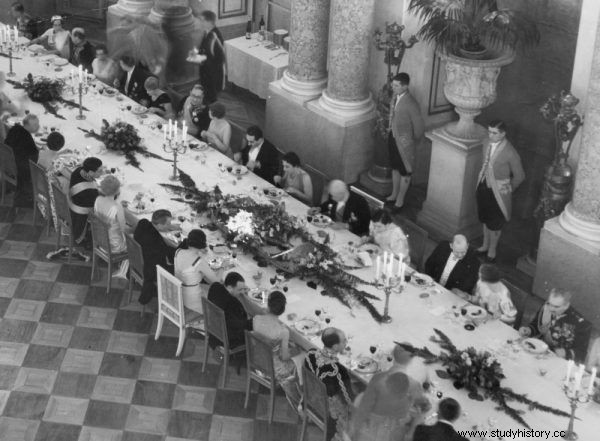
President Mościcki with his guests during a meal at the Royal Castle (photo:public domain).
Although the image painted by the presidential guard does not create a flattering image of our elite at the time, let us not go overboard. The Royal Castle visitors were not a horde of Huns clad in ballroom toilets.
If we exclude the notorious "regulars" who visited all possible parties in the capital to fill themselves with tarts and free alcohol (people who plan completely modern events in the capital also know such cases), and people who were completely unable to behave, because no one he hadn't taught them this, there was quite an elegant and elegant company.
Anyway, people who seemed to fit like a fist to the nose were brought to the Castle by the President herself. Michalina Mościcka was known to be eagerly involved in the activities of centers helping young girls. On the occasion of various receptions, she invited simple ladies who lived in them, for whom a visit to the head of state and meeting with elegant company was an unforgettable experience.
Bibliography:
The article is based on the sources and literature used by the author while working on the book "Twenty years from the kitchen. Culinary history of pre-war Poland ”. The author used, inter alia,:
- Barbasiewicz M., Good manners in pre-war Poland , Warsaw 2012.
- Beck J., When I was your Excellency , Warsaw 1990.
- Janicki K., First Ladies of the Second Polish Republic , Krakow 2012.
- Kirkor-Kiedroniowa Z., Memories , vol. 1, Krakow 1986.
- Piłsudska A., Memories , Warsaw 1989.
